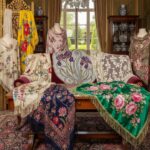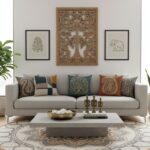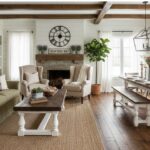The Fabric of Time: Tracing Upholstery in Antique Furniture Design
Imagine stepping into an old manor house. You run your fingers over a faded tapestry of rosebuds on a wingback chair, or press gently into a tufted velvet seat and feel the spring resilience beneath its surface. Antique furniture holds a timeless charm that reflects the craftsmanship and beauty of bygone eras. However, that touch—soft, textured, layered—is not just about the furniture but also the upholstery. It is history, whispered in threads and stitches. Antique Upholstery does more than cushion: it captures the spirit of an age. Unlike modern pieces, which are often mass-produced with synthetic materials, vintage upholstery was crafted with care, using techniques that ensured durability and elegance.
Upholstery is often overlooked when we admire antique furniture—people tend to focus on the wood, the carving, the silhouette. But the choice of fabric, the stuffing, the stitching style—the whole upholstery package—speaks volumes about cultural values, technology, trade, and aesthetics of its time.
In this blog, we’ll trace the history of upholstery, how upholstery evolved over centuries, and how it changed antique furniture.
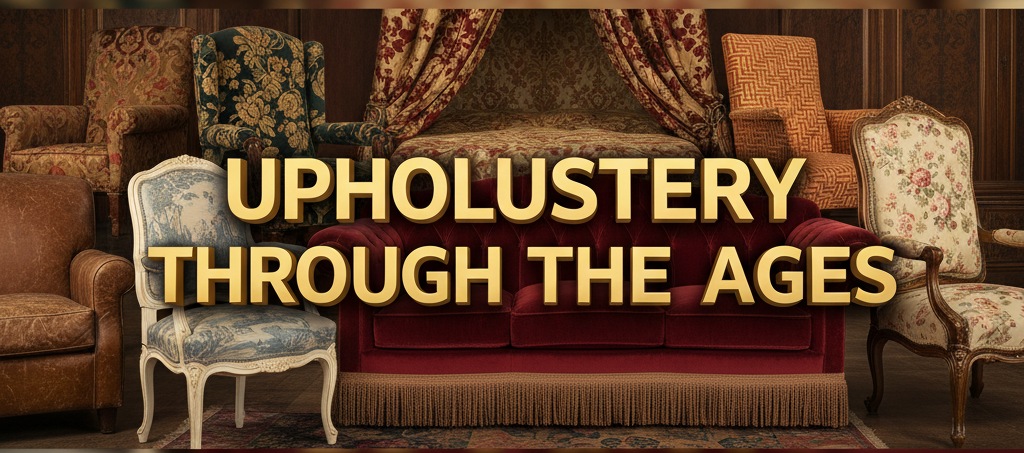
Also Read: Sustainable Antique Furniture
Understanding the Importance of Antique Furniture Upholstery
Upholstered furniture has a rich history that spans centuries. Before we dive into the chronology, let’s understand the profound impact upholstery had. Early furniture was often hard – wooden benches, stools, and chests. While cushions were used for comfort, permanent upholstery as we know it didn’t exist until much later.
What Upholstery Adds to Furniture:
- Comfort and Luxury: This was the most immediate and appreciated addition. Layers of stuffing (horsehair, feathers, straw, wool) covered by beautiful fabrics transformed rigid seating into inviting oases of comfort, a clear status symbol.
- Aesthetic Enhancement: Upholstery added colour, pattern, texture, and visual softness to furniture. It allowed for intricate designs, rich tactile experiences, and a cohesive decorative scheme within a room.
- Status and wealth signal: Luxurious fabrics were expensive imports. To own silk brocade or velvet upholstery signalled taste, refinement, and purchasing power.
- Preservation and adaptation: Upholstery can protect the underlying structure (e.g. covering joints, dampening wear). Over time, reupholstery also allows a piece to adapt to changing tastes and prolong its life.
Upholstery Through the Ages: A Textile Timeline
- Ancient Origins: Leather, Skins, and Woven Mats
The origins of upholstery can be traced back to ancient civilisations. In ancient Egypt, chairs and stools were made from woven rush mats or animal skins stretched across wooden frames.
The Greeks and Romans improved on this by using goat or sheepskins and padding with down or feathers to create rudimentary cushions.
These primitive forms set the precedent: make wood more hospitable, more human.
- Medieval & Renaissance: Straw, Horsehair, Tapestries
In the Middle Ages, simple benches and stools gave way gradually to chairs with backs and seats stuffed with coarse materials—hay, straw, or horsehair.
Upholstery remained functional, not decorative, until the Renaissance.
- The Renaissance
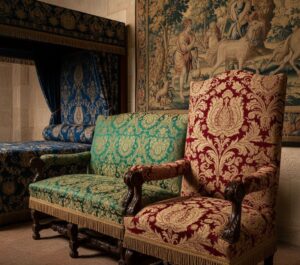
The Renaissance period marked a significant evolution in upholstery techniques. Skilled artisans began to experiment with intricate designs and richer materials, elevating upholstery to an art form.
Think heavy, imported fabrics like velvet, brocade, and damask, often in rich jewel tones (crimson, emerald, gold). These were typically fixed to benches, high-backed chairs, and coffers, secured with large decorative nails.
- 17th–18th Centuries
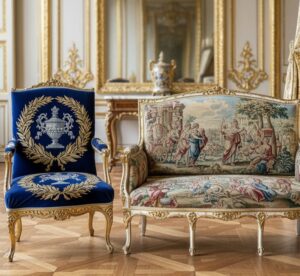
This period marks the golden age of upholstery craftsmanship, where the fabric choice became as significant as the wood design.
During the 18th century, upholstery evolved from a practical craft to a refined art form.
- Rococo: Upholstered furniture during this period often featured richly embroidered or woven fabrics, such as silks and brocades, in vibrant colours.
- Neoclassical: As the century progressed, the Neoclassical style gained prominence, drawing inspiration from ancient Greek and Roman design. This style emphasized symmetry, clean lines, and classical motifs.
- Victorian era: Coiled springs became more common, leading to deeper and more cushioned seating. Plush fabrics like velvet, damask, and brocade were used, often in deep, rich colours.
- Craftsmanship: There was a heavy reliance on manual craftsmanship and techniques passed down through generations.
- 19th Century: Innovation and Mass Production
The Industrial Revolution further transformed upholstery. Mass production techniques made upholstered furniture more accessible to the general public.
The Eastlake movement (late 19th century): It advocated simpler ornamentation, cleaner forms, and even the idea that furniture should be practical and orderly.
Revivals: Alongside these, revival styles (Rococo revival, Renaissance revival) brought back classical upholstery motifs, but often using newer blends and synthetic dyes.
- Early 20th Century & Art Deco / Modernism
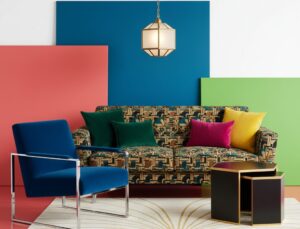
In the early 20th century, lighter fabrics, cleaner lines, and new materials (cottons, linens, and early synthetics) became more common. The bold geometry of Art Deco favoured streamlined upholsteries — fewer florals, more stylized forms.
Interwar and mid-century styles moved toward minimalism, fabrics with crisp lines, and a less-is-more philosophy. Reupholstery sometimes reflected modern tastes over original ones.
- Late 20th Century to Today
From about mid-century onward, synthetic fibres, blends (nylon, polyester), and mechanised upholstery techniques became prevalent. Durability, stain resistance, and cost-efficiency gained priority.
The Enduring Worth of Upholstered Antique Furniture Today
In today’s design landscape, upholstered antique furniture holds immense value, both aesthetic and monetary:
- Historical Significance: Each piece is a tangible link to the past, a fragment of an era’s design philosophy and social customs. The original upholstery, if well-preserved, significantly increases its historical integrity and value.
- Craftsmanship: Antique upholstered pieces often represent a level of hand-craftsmanship – from the frame construction to the intricate stuffing methods and textile weaving – that is rare and expensive to replicate today.
- Unique Character: Unlike mass-produced modern furniture, antique pieces offer unique character, patina, and a sense of history that cannot be replicated.
- Sustainability: Reusing and appreciating antique furniture is an inherently sustainable practice, reducing demand for new manufacturing.
- Investment Potential: Well-maintained and authentic antique upholstered furniture, especially pieces with documented provenance or rare original fabrics, can appreciate in value, making them sound investments for collectors.
Factors that drive value
When considering upholstered antique furniture for your home, remember that original upholstery, even if worn, often tells a more authentic story.
- Originality vs Restoration: Furniture that retains original upholstery (or close to it) is more prized. However, original upholstery often deteriorates.
- Quality of craftsmanship: The more intricate the upholstery technique (hand-stitched tufting, fine spring systems, traditional materials), the better.
- Period and rarity: Examples from celebrated makers, unique styles, or important commissions command premium prices.
- Provenance and condition: Documentation, stamps, maker’s marks, and a well-preserved frame greatly influence value.
Conclusion: Threads That Echo Time
From the stiff, regal velvets of the Renaissance to the crisp, clean lines of Mid-Century Modern weaves, upholstery has always been far more than just fabric and stuffing. It has been a mirror reflecting societal tastes, technological advancements, and evolving definitions of comfort and luxury.
For collectors, the right upholstery enhances both aesthetics and value. Choosing correct fabrics, preserving provenance, and applying skilled restoration are key to maintaining that value.


